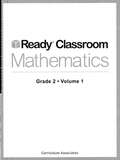- Table View
- List View
Ready Tennessee, Mathematics Instruction [Grade] 6
by Ruth Estabrook Matt PollockNIMAC-sourced textbook
Ready Tennessee, Mathematics Instruction [Grade] 7
by Ruth Estabrook Matt PollockNIMAC-sourced textbook
Ready Tennessee, Mathematics Instruction [Grade] 8
by Ruth Estabrook Matt PollockNIMAC-sourced textbook
Ready Tennessee, Mathematics Practice and Problem Solving [Grade 1]
by Kathy Kellman Ruth Estabrook Matt Pollock Penny Dowdy Pamela Halloran Sarah Kraus Djana Paper Susan Rogalski Sam Valentino Julia BourqueNIMAC-sourced textbook
Ready Tennessee, Mathematics Practice and Problem Solving [Grade] 7
by Pam Halloran Lauren Van Wart Sarah Kraus Sam Valentino Stacie CartwrightNIMAC-sourced textbook
Ready Tennessee, Mathematics Practice and Problem Solving [Grade] 8
by Pam Halloran Kathy Kellman Lauren Van Wart Ruth Estabrook Matt Pollock Penny Dowdy Sarah Kraus Sam Valentino Stacie CartwrightNIMAC-sourced textbook
Ready Common Core, Mathematics Instruction [Grade] 6
by Curriculum Associates LlcNIMAC-sourced textbook
Ready New York COS 8 Mathematics Instruction
by Cynthia TrippReady® New York COS 8 Mathematics Instruction
Mathematics Instruction [Grade] 5 (Ready North Carolina)
by Pam Halloran Kathy Kellman Lauren Van Wart Ruth Estabrook Penny Dowdy Sarah Kraus David PolakoffNIMAC-sourced textbook
Mathematics Practice and Problem Solving [Grade] 3 (Ready North Carolina)
by Sarah Kraus David PolakoffNIMAC-sourced textbook
Ready Classroom Mathematics: Grade 2
by Curriculum AssociatesReady Classroom Mathematics Grade 2 | Volume 1
Ready Classroom Mathematics: Volume 2
by Curriculum AssociatesTable of Contents <p><p> UNIT 4 Fractions Equivalence and Comparison, Measurement, and Data <p><p> UNIT 5 Measurement Time, Liquid Volume, and Mass <p><p> UNIT 6 Shapes Attributes and Categories, Perimeter and Area, and Partitioning <p><p>Grade 3
Ready Classroom Mathematics Grade 4 - Volume 2
by Curriculum AssociatesReady® Classroom Mathematics Grade 4 - Volume 2 covers Unit-4 and Unit-5. Unit-4 Fractions, Decimals, and Measurement Addition, Subtraction, and Multiplication contains Lesson-17 to Lesson-29. Unit-5 Geometry and Measurement Figures, Classification, and Symmetry contain Lesson-30 to Lesson-34. This book also has a Bilingual Glossary.



